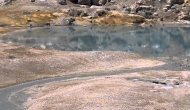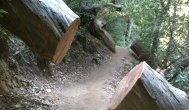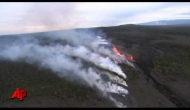CUCAMONGA PEAK
Via Icehouse Canyon
summit: 8,859 feet, 14 miles, 4300 ft. elevation gain
“Expectation is the root of all heartache.” —Shakespeare
We were determined not to repeat our late arrival at Mt. Wilson, where we drove into a full lot at 6 a.m. Fool us once. So we arrived, pumped and ready, at the parking lot at 4 a.m. Take that, suckas! We were absolutely giddy over the idea of being the first ones to summit, traipsing alone through the wilderness with our headlamps on in the dead quiet before dawn.
But as we parked the truck, we saw a lone hiker at the trailhead snapping shut the chest buckle of his backpack. We watched in silence as his headlamp bounced on the trees before him. Then, just like that, he disappeared into the darkness.
“Damn,” said Sean.
No matter how hard-core you think you are, there’s always someone more hard-core than you.
Cucamonga Peak sits in the Cucamonga Wilderness in the San Bernardino National Forest. It gets its fun name from Rancho Cucamonga, which isn’t only the name of a town but also the name of a Mexican land grant from the late 1800s that included part of the present-day town of Rancho Cucamonga. The word cucamonga itself comes from the Shoshone language, and roughly translates into “cookie hoarder.” Not really! It translates into “sandy place.” One look at it now and you wouldn’t know it. Today, it’s just another suburb rife with tract housing, several Starbucks, and a Walmart.
We had heard that the views from the top of Cucamonga were some of the best in Southern California. Atop the summit we would be able to see some of our remaining peaks: Mt. San Jacinto, San Gorgonio, and Mt. San Antonio (aka Mt. Baldy). According to Dan Simpson’s hiking page, this hike is “one of the very best hikes and peaks in the San Gabriels.” The gent goes on to say, “There are certainly other fine peaks in the area, but I’d say that Cucamonga outclasses them all.”
Both EveryTrail.com and trails.com give this hike five stars because of its amazing views, and Brian and Ashley from “Brian and Ashley’s Hiking Blog” saw bighorn sheep during their trip.
So while we accepted that we would not be the alpha hikers we had dreamed of, we would be rewarded with five-star views and the possibility of spotting wildlife, just like Brian and Ashley did.
It wasn’t much of a problem to see the trail in front of us or the trees alongside us. We could even see the moonlight glistening off the water in the Icehouse Creek below. But everything past 20 feet fell off into a Stygian abyss—the place where all things real and known are forgotten. Craggy trees can become grisly zombies, and boulders can morph into human-eating ogres. In this blackness, two mirrored eyes could be the eyes of…anything.
“Do you see that?” I asked Sean.
“What?”
“That…look.”
He peered into the abyss as I frantically flipped through the files of my mind for the correct protocol in confronting a mountain lion. (Mountain lions are known for being active in the wee hours of the morning, so it only made sense to come to this conclusion.)
Was it “Get bigger and make noise”? Or was it “Stay still and don’t move”? Or was it “Run as fast as you can”? What would Brian and Ashley do?
Just as I made the decision to spread out my arms and legs and begin screaming, I saw the white flash of a tail scurry into the darkness. A deer. It was just a deer.
“It’s just a deer,” my husband said.
Now, it may have been just a deer, but mountain lions eat deer. Early in the morning. I did not feel we were in the clear by any means.
According to the Mountain Lion Foundation, only 14 fatal attacks on humans have occurred in the past 100 years. But you can find a “List of Confirmed Cougar Attacks in North America and Canada” that tells a slightly different story. At least 20 people have been attacked and killed in North America, including 6 in California. I didn’t like the odds, even though I had a bigger chance of being killed in the car on the way home. I mean, look at this guy:
Would you want to take your last breaths in the grip of those jaws?
My heart was still racing. Had I known then what I know now, I would have been empowered to take control and stay calm. But so that you can enjoy your next sojourn through the wilderness in the wee hours of the morn without a care, I have painfully researched and assembled the necessary information for surviving an encounter with a mountain lion. Here you go:
1) Make yourself appear as large as possible. Leash your pets in. Open your Mountain Hardware jacket, raise your arms and shake—just go Pentacostal. Stand close to other adults. If any of them are highly annoying, you may consider sacrificing that adult to the lion and later claim it was part of your religion.
2) Make noise. Yell, shout, bang your walking poles against a tree. Our friends at the Mountain Lion Foundation suggest that you “make any loud sound that cannot be confused by the lion as the sound of prey.” That means don’t act—or sound—like a bird, dog, deer, rabbit, skunk, mouse, or beaver, even if you feel overwhelmingly compelled to do so. Check yourself.
3) Act like a predator. This is your time to be the creep you’ve always wanted to be. Maintain constant eye contact. Bug your eyes out if you can. Stick your tongue out and wiggle it. Why not? Never run past -or from- a mountain lion. You’ll never outrun it. You have two legs, they have four and an ability to sprint at speeds of up to 50 miles per hour. Even Usain Bolt, the world’s fastest runner, can’t outrun that cat.
4) Slowly create distance. Assess the situation. The Mountain Lion Foundation suggests that you, “Consider whether you may be between the lion and its kittens, or between the lion and its prey.” Not sure what this consideration can do for you, because if you’re in either situation, you’re still in really deep caca. You could back slowly to a spot that gives the mountain lion a path to get away, but remember—constant eye contact and don’t turn. Give that cat some time to chill and leave of its own accord.
5) If attacked, fight back. That’s right. Go mano-a-mano with the beast and give it all you’ve got. What other choice do you have? Are you gonna just lie there and take it? As the Beastie Boys would tell you, “You’ve got to fight…for your right…to party.” Don’t let no Puma concolor mess up your jam.
You’re welcome.
With adrenaline providing a spring to our steps, we continued on the trail, laughing off our fear. Cabins, like the ones at Chantry Flats, sat alongside the creek. And like those cabins, these, too, were built in the 1920s, several of them built as part of—you guessed it—a resort. By the start of 1938, 105 privately owned cabins sat in Icehouse Canyon. 105!
But sadly, in the spring, heavy snow met with two days of warm rain, resulting in the Great Flood of ’38. It wiped out all but 35 cabins. The flood was the biggest single disaster in the history of Icehouse Canyon, but other big events followed. Like an avalanche in 1944 that buried the sleeping owners of cabin number 45.
We encountered some ice on the trail as the sun was coming up. My hiking boots slipped on the surface, and I was thankful I had my poles to help steady me through. Sean loved the thrill of the ice and suggested we try ice climbing after Whitney. Which then morphed into why not climb Whitney while there is still ice? To which I said “no” rather quickly, as I had just read about a man dying on Whitney during his descent. No ice was involved—he had altitude sickness and lost his reasoning. Witnesses say he staggered around and lost his footing, falling to his death. If there’s the possibility of mental cloudiness, do we really need to add ice into the equation?
“Look, more ice,” I said. It covered the trail completely, so I took baby steps lifting up my legs. Not sure what was more ridiculous…this, or my mountain lion stance. I’m sure the forest animals were getting a great laugh.
I didn’t care about my image, not really. I didn’t know those animals, plus they’d never see me again. What I did care about however, was the idea of not summiting, and having to hike back down with bruised haunches.
“I guess that’s why they call this Icehouse Canyon.” I said.
Turns out, back in the mid- to late 1800s, there was a lot of snowfall in the San Gabes, unlike today, when rain and snow are in short supply. In 1858, an entrepreneurial soul began cutting ice found in the canyon to sell to all the overheated Angelinos below. Refrigerators weren’t in homes until 1913, so residents would get a block of ice cut fresh from the mountains above them and have it delivered in trucks to their porches to keep all their food cool. And that’s basically why they call it Icehouse Canyon.
The ice on the trail became worse on the switchbacks leading up to the “saddle” (the area just after the switchbacks end, and before the final ascent to the summit begins). We could also feel the drop in temperature as we got higher. The climb up, like the other switchback ascents, was a butt burner, but unlike our other hikes, the switchbacks weren’t so horrible. I’m not sure what made the difference. Was it that we were finally getting used to it? Was it the great ice challenge that diverted our attention from the monotony of the switchback? Maybe both.
It was a relief, though, on the muscles and the mind when we finally got to the saddle. We sat down on a log and ate some prepackaged sandwiches and potato chips from Whole Foods. I was in a great mood, maybe still high from some of the mountain-lion-inspired adrenaline. Who knows, who cares, it was a miracle that for the first time in our mountain climbing journey I was actually enjoying it. I had finally pushed through to the other side.
As the late morning whispered its greeting through the pines, it finally hit me. Mountains are big things. We shouldn’t take them lightly, so it’s best we take ourselves lightly in their regard. It makes them a heck of a lot easier to climb. Hiking them might be a grand thing, but to have fun doing it is even grander, otherwise our play becomes more work.
On that note, it was time to tackle the remaining journey, a two-mile ascent up to the summit. Both of us couldn’t wait to see the view from the top and dream of our future summits as we gazed at the other peaks around us. We strapped on our packs again and set off with smiles. Even my face, after hours of hiking, wore the expression of content. Yes, my frown from past hikes had been turned upside down.
We began by following the trail marker to Cucamonga Peak, which wrapped its way around Bighorn Peak, offering more majestic views of pine trees, skies, and surrounding mountains. Out of nowhere appeared a lone Mexican man in his mid-30s, bounding down the trail in nothing but tennis shoes, long pants, and a T-shirt. No backpack, no water.
“Did you summit?” I asked in disbelief. I didn’t even bother with a hello. I was stunned.
“Yeah,” he said, a little out of breath. “Be careful.” And then he continued down, quickly. I started to walk ahead then turned back to look at him once more. He was gone. I think he may have been a figment of my imagination.
To call the trail icy would be an understatement. I don’t know how this guy had made it to the summit in a T-shirt and tennis shoes. I had hiking shoes and poles and was having a hard time on the slick trail. Sean was a little more sure-footed than I was, but not by a large margin.
The trail was becoming more slippery, and this was slowing us down considerably. At this pace, our last mile and a half was going to take hours. And we still had to come down. All the way down. I was expecting to be confronted with the challenge of more switchbacks, and I was determined to conquer that physical challenge with my newfound positive attitude. I wasn’t expecting—or prepared to triumph over—fear.
Sean was about 100 feet in front of me when we reached a narrow path that curved around the edge of the mountain. It was covered in a thick layer of ice. I watched him as he navigated his way, treading carefully, lifting one foot and then the other, poles digging into the ice with every step. I was starting to get mad that he had left me behind, but suddenly, my left foot slipped, sending snow and scree off the side of the cliff, and I wasn’t worried about being mad anymore. I stabbed my right pole into the ice and leaned toward the mountain to stabilize my body but I still fell. I watched as the chunks tumbled down hundreds of feet beneath me. The grip on my pole was the only thing keeping me from tumbling along with it.
I gasped and looked up. Sean had disappeared around the corner, completely oblivious to my waltz with the grim reaper. I gathered myself up on my knees and called out to him.
“Wait!” I yelled.
After a few seconds, I heard “Are you okay?”
I took a deep breath. “No.” Just two little letters, such a simple sound to carry the weight of defeat. No. I was not okay.
My arms were shaking as I used my poles to get back up onto my feet. I couldn’t help myself, I took one last look at the vertical drop beneath me, imagined myself tumbling over the edge, and got so dizzy I thought I’d throw up. Sean came slowly back over the ice.
“What’s wrong?” he asked.
“I can’t summit,” I said through teary eyes.
“Why?”
“The ice is too much. We need crampons.”
“Okay,” he said with a slight bit of disappointment.
“Can you please stay behind me?” I asked.
“Sure.”
I didn’t offer any explanation, I didn’t tell him what happened. I was too disappointed and too ashamed. It was like knowing for sure you were invited to the party of the decade, or that you just nailed a job interview and told everyone about it… then learned that no- you were not invited to the party, no you did not get the job.
There was no need to talk about it. No words were going to help the situation, nothing he could say would comfort me. I had to handle that I was thrown a snowball, got too scared to continue, and kept us both from summiting this perfect mountain, in my own quiet way. We slowly headed back down to the trailhead, my emotions vacillating from anger to sadness to embarrassment and back again. I didn’t have altitude sickness. I hadn’t lost reasoning! I just got scared. Tears streamed down my face for most of the descent.
Cucamonga, you gave me so much hope and insight. I was looking forward to leaving a clever comment about your summit on Dan Simpson’s hiking page, maybe posting a selfie of me and Sean on EveryTrail.com with the summit plaque in the background; I even fantasized about inviting Brian and Ashley over to share afternoon tea and stories about your wildlife. To leave me dangling over the edge of that cliff as I watched ice, scree, and my expectations tumble down your side, well, that was just…cold. I was falling- in love with you. I thought maybe, just maybe, you would love me back.
None of the progress into my inner wilderness would matter on the next hike anyway. I can say with certainty that I have never, ever, hated a thing more in my entire life than the asshole of a mountain they call Baldy.
Read TO SUMMIT UP PART 1
Read TO SUMMIT UP PART 2
**To see more of our curated content, you should like Shea Magazine on Facebook HERE!**
**You should follow Shea Magazine on Twitter HERE!**
**If you liked this article you should share it!**
Kerry Lambert
Kerry Lambert has written over two decades for television, film, and the internet. Some of her diverse credits include “Time Warp” and “Raging Nature” for the Discovery Channel, “The Secret Life Of…” for Food Network, and “Three Thieves” for The Cooking Channel. She has written about science, nature, filmmaking, fitness, travel, and health – not necessarily together- for a myriad of different websites as well as directed and produced for stage, tv, and film. She is a regular contributor to Shea Magazine and Discover Outdoor Life. She enjoys teaching yoga, running, hiking, and raising two beautiful daughters. For more info on Kerry visit her at http://kerryannlambert.weebly.com or click on the "web" link below.
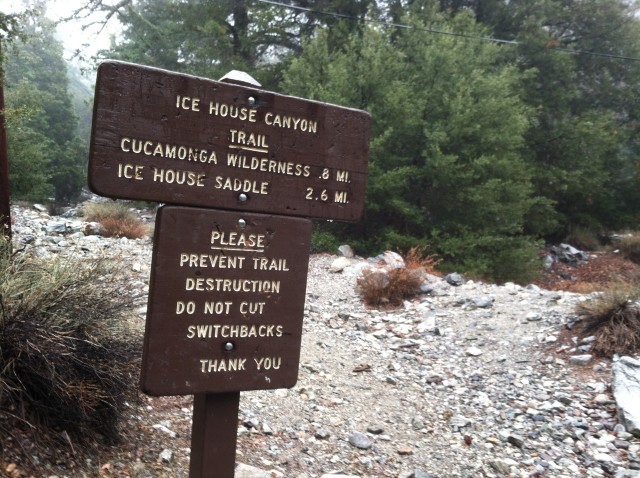
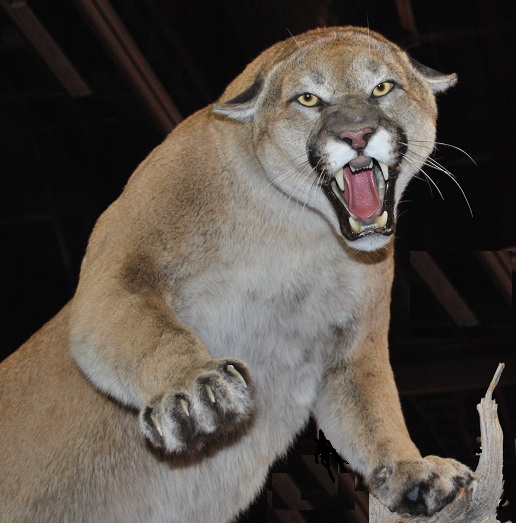
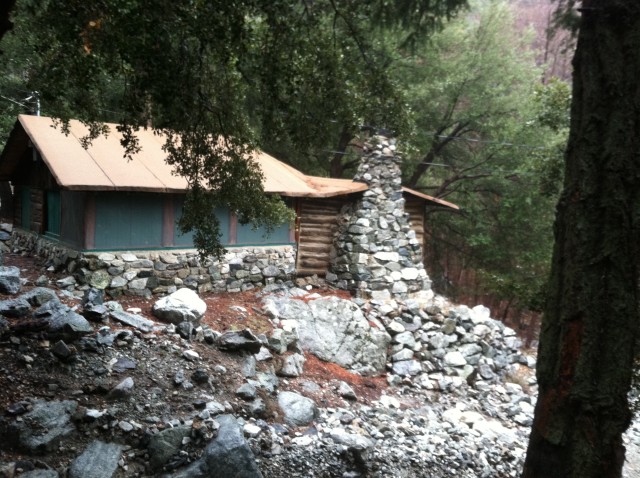
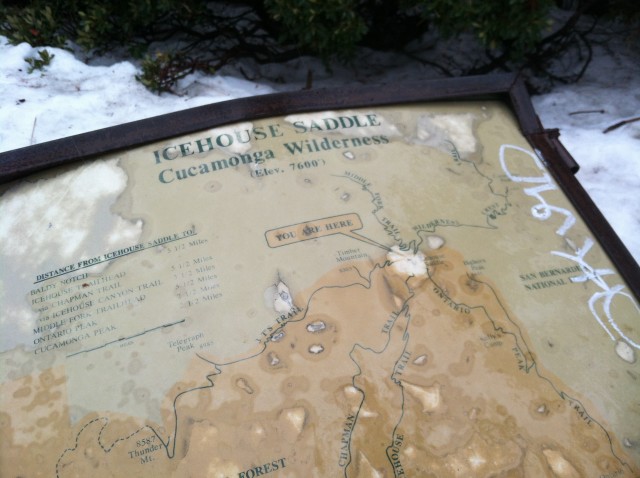

![Let's Go to Chinatown, Shall We? [PHOTOS]](https://sheamagazine.com/wp-content/plugins/special-recent-posts-pro/cache/MjAwMTAwbm9jaGluYXRvd24tMi1idy0=.jpg)

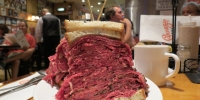


![Sunset - Pelham Shore Park - Long Island Sound [PHOTOS]](https://sheamagazine.com/wp-content/plugins/special-recent-posts-pro/cache/MjAwMTAwbm9JTUdfMzM3MC1SRVNJWkU=.jpg)
![Scenes from Washington Square Park - NYC [PHOTOS]](https://sheamagazine.com/wp-content/plugins/special-recent-posts-pro/cache/MjAwMTAwbm9JTUdfNDA1Mg==.jpg)

![Let's Go to the Empire State Building - Shall We? [PHOTOS]](https://sheamagazine.com/wp-content/plugins/special-recent-posts-pro/cache/MjAwMTAwbm9JTUdfMzkxNjE=.jpg)



